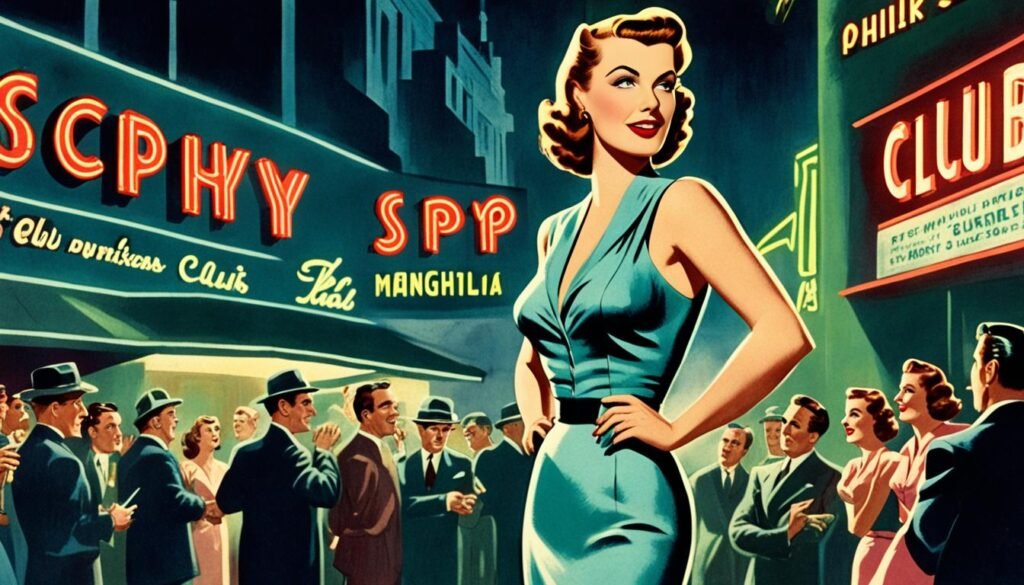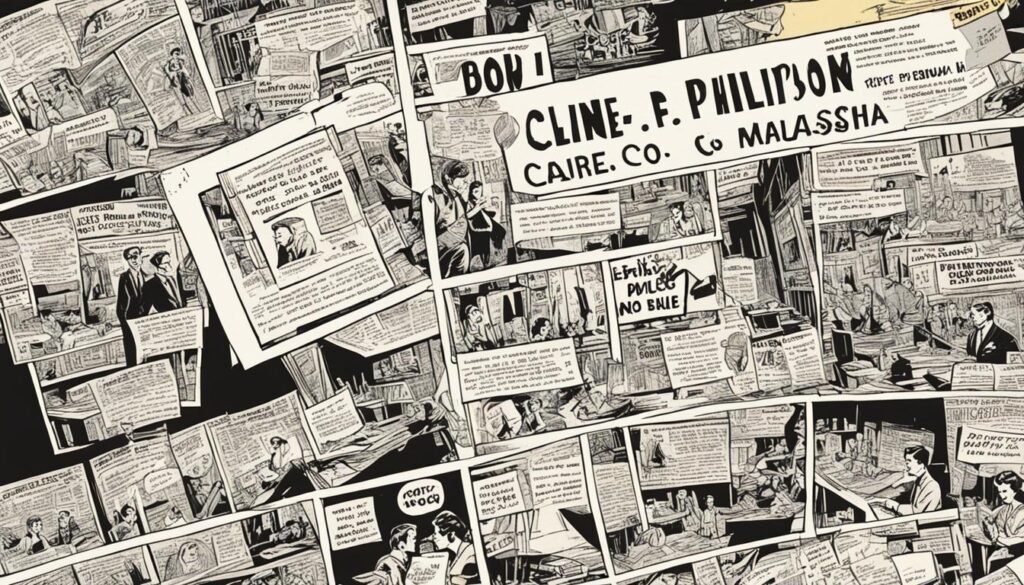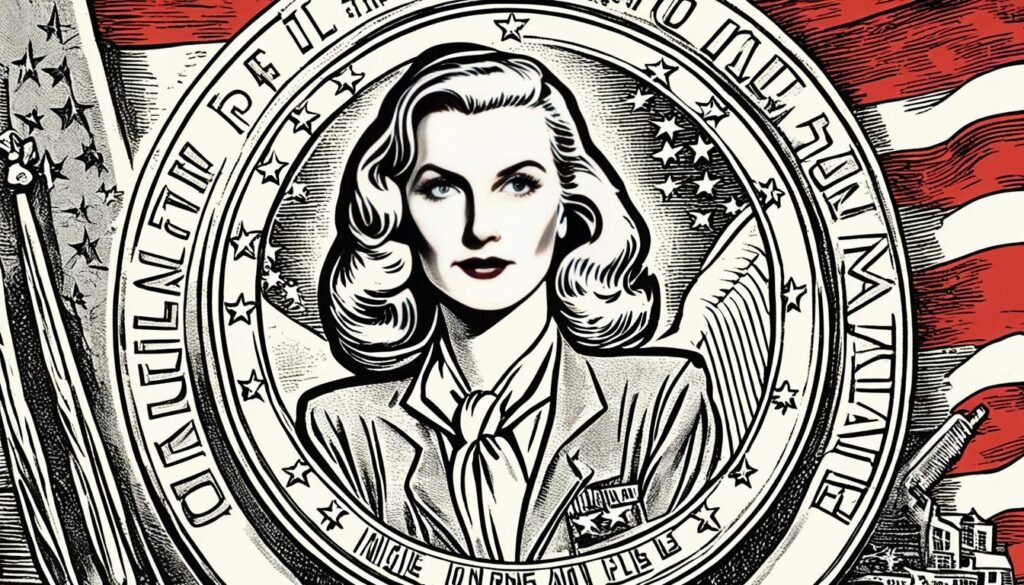Did you know that Claire Phillips, an American entertainer and club owner, defied the odds and became a renowned spy during World War II in Japanese-occupied Manila? Her daring espionage activities and acts of heroism have left a lasting impact on history.
Key Takeaways:
- Claire Phillips was an American entertainer and club owner who became a spy during World War II in Manila.
- She established the “Miss U Spy Ring” and gathered intelligence from Japanese officials.
- Claire Phillips played a vital role in smuggling aid to prisoners of war held at the Cabanatuan camp.
- She was awarded the Medal of Freedom for her bravery and contributions during the war.
- Claire Phillips’ story continues to inspire and captivate audiences today.
The Enigmatic Beginnings of Claire Phillips
Claire Phillips, born Claire Maybelle Snyder in Michigan in 1907, had an eventful early life. After running away to join a traveling circus, she embarked on a journey that would shape her future in the entertainment world.
From a young age, Claire’s fascination with the circus drew her away from her hometown and into a world of excitement and wonder. She embraced the nomadic lifestyle and found solace in the vibrant atmosphere of the big top. The circus became her playground, where she honed her performance skills, captivating audiences with her talents.
As Claire’s passion for entertainment grew, she ventured beyond the boundaries of Michigan, exploring the vast entertainment opportunities across the United States. Her journeys took her to various cities, theaters, and vaudeville stages, where she continued to develop as a performer, refining her craft.
However, Claire’s ambitions were not confined to American soil. Her thirst for adventure led her to venture even further, all the way to East Asia. From vibrant cities like Hong Kong to Manila, the entertainment hub of the Philippines, Claire sought new stages to shine on.
Little did Claire know that her journey from the small town of Michigan to the bustling entertainment capitals of East Asia would set the stage for her future accomplishments as a spy and nightclub owner. Her early experiences would ignite a fiery spirit within her, propelling her towards a destiny that few could have anticipated.
Claire Phillips’ Pre-War Ventures in Nightclubs
In the 1930s, Claire Phillips embarked on a journey that would lead her to become a prominent figure in the nightclub scene. Starting in the northwest of the United States, she honed her talents as an entertainer, captivating audiences with her performances. It was during her tour in Manila that Claire’s life took a significant turn.
The Filipina Connection: Romance and Performance
While in Manila, Claire Phillips found more than just a thriving entertainment industry. She also discovered love. She met and married Filipino sailor Manuel Fuentes, a connection that would shape her life in the years to come. Their romance blossomed amidst the vibrant atmosphere of Manila’s nightclubs, fueling Claire’s passion for performance and adventure.

Journey to Manila: Establishing a New Life
Despite the eventual end of her marriage to Manuel Fuentes, Claire Phillips was drawn back to Manila, where she saw the potential for a fresh start. In the bustling city, she pursued her career in the nightclub scene with renewed vigor. Manila provided her with a platform to showcase her talent, attracting audiences and establishing herself as a captivating performer.
While Claire’s relationship with Manila was not without its challenges, the city became her home, offering her opportunities for growth and self-discovery. Through her work in the nightclubs of Manila, Claire Phillips laid the foundation for her remarkable journey as a spy, entertainer, and hero.
Discover more about Manila’s vibrant nightlife during Claire Phillips’ era.
Claire Phillips Meets John V. Phillips: Love Amidst War
In the midst of the turmoil and uncertainty of World War II, Claire Phillips found an unexpected love that would change the course of her life forever. While stationed in Manila, Claire met Sgt. John V. Phillips of the 31st Infantry Regiment. Their connection was immediate and undeniable, as love blossomed amidst the chaos of war.
Amidst the lush jungles of the Philippines, Claire and John exchanged vows in a small, intimate ceremony, defying the dangers that surrounded them. Their union symbolized hope and resilience in the face of adversity, a testament to the power of love even in the darkest of times.
However, their joy was short-lived as Manila came under threat from the Japanese occupation. Faced with imminent danger, Claire and John made the heart-wrenching decision to leave their beloved city behind and embark on a treacherous journey to safety.
Together, they embarked on a perilous flight from Manila, navigating through treacherous terrain and evading enemy forces. The jungles of the Philippines became their sanctuary, as they fought for survival and clung to the promise of a brighter future. Throughout their journey, their love served as a beacon of hope, giving them the strength to overcome countless challenges and persevere against all odds.
https://www.youtube.com/watch?v=2HySmHxRKSY
Despite the uncertainty and dangers they faced, Claire and John’s love remained unwavering, sustaining them through the darkest moments of their journey. Their remarkable resilience and devotion to each other would become a testament to the power of love amidst the chaos of war.
The Transformation of Claire Phillips into “High Pockets”
During her time in Manila, Claire Phillips underwent a remarkable transformation, adopting the nickname “High Pockets.” This alias would become synonymous with her espionage activities and acts of bravery during World War II. As “High Pockets,” Claire Phillips carried out dangerous missions, gathering crucial intelligence and smuggling aid to prisoners of war.
Her alias, “High Pockets,” encapsulated her resourcefulness and ingenuity. Just as her pockets concealed valuable supplies and hidden messages, Claire Phillips concealed her true identity and intentions, operating undercover in a world wrought with danger and uncertainty.
The name “High Pockets” not only represented her ability to hide crucial supplies on her person, but it also symbolized her unwavering commitment to her mission and her dedication to the cause of defeating the Japanese forces. She became a beacon of hope, demonstrating extraordinary courage and determination in the face of adversity.
“High Pockets was always the go-between with the resistance and Corregidor. As an entertainer, she was able to move around freely without suspicion and pass information to the American Army in hiding.”
Claire Phillips, or “High Pockets,” operated in the shadows, using her position as an entertainer and nightclub owner to gather intelligence from Japanese officials and relay it to the American forces. Her undercover operations at Club Tsubaki provided a crucial line of communication between the resistance and Corregidor, helping to coordinate efforts and support the war effort.
Through her transformation into “High Pockets,” Claire Phillips became an integral part of the espionage network in Manila. Her actions and bravery elevated her from a mere nightclub performer to a legendary figure in wartime history.

Club Tsubaki: A Nightclub for Espionage
Claire Phillips, also known as Dorothy Clara Fuentes, was not only a talented entertainer but also a cunning spy during World War II. Her nightclub, Club Tsubaki, served as a front for her espionage activities, allowing her to gather crucial intelligence in Japanese-occupied Manila.
Within Club Tsubaki, Claire formed the “Miss U Spy Ring” alongside her fellow dancer, Fely Corcuera. Together, they embarked on daring missions to decode Japanese officials and extract valuable information regarding troop movements.
By interacting with Japanese officers in the glamorous setting of the nightclub, Claire and Fely were able to discreetly gather intelligence and transmit it to American forces in the Pacific. Their bravery and resourcefulness in the face of danger played a significant role in aiding the Allies’ efforts during the war.
For a deeper insight into Claire Phillips’ thrilling spy activities, you can read the tragic story of the Manila club singer who spied for the Allies in WWII.
Claire Phillips’ Undercover Operations
In addition to her intelligence-gathering activities, Claire Phillips played a key role in smuggling aid to prisoners of war held at the Cabanatuan camp. She used her nightclub and her ingenuity to hide and transport essential supplies to the prisoners. Her ability to conceal messages and items earned her the nickname “High Pockets” among the prisoners.

Secrets Beneath the Sequins: Smuggling Aid to POWs
Under the cover of her glamorous nightclub, Claire Phillips became a master of clandestine operations. She ingeniously hid essential supplies, such as medicine, food, clothing, and even tools, beneath the sequins and glitter of her performances. With every dance, every movement, she smuggled aid to the desperate prisoners of war, providing them with a glimmer of hope in their arduous captivity. It was through her covert efforts that she saved countless lives and brought comfort to those who had lost everything.
Earning the Moniker “High Pockets”
Claire’s ability to conceal messages and items within her clothing earned her the nickname “High Pockets” among the prisoners. She used hidden pockets, sewn into her costumes, to transport valuable information, intelligence, and supplies. These secret pockets became a lifeline for the prisoners, as Claire fearlessly risked her life to ensure the success of her undercover operations. Her resourcefulness and dedication to helping others made her a true hero of the war.
| Aid Smuggled to POWs | Impact on Prisoners |
|---|---|
| Medicine | Provided much-needed medical care for the sick and injured |
| Food | Eased hunger and malnutrition, improving prisoners’ well-being |
| Clothing | Offered warmth and comfort in harsh conditions |
| Tools | Enabled prisoners to repair and maintain their living conditions |
Imprisonment and Torture: Testing Claire Phillips’ Resilience
The Japanese authorities eventually discovered the activities of Claire Phillips and her spy ring. She was apprehended, tortured, and held in Bilibid Prison in Manila. Despite enduring brutal treatment and near-starvation, she refused to provide useful information to her captors. Her resilience and bravery were truly remarkable.
The Question of Veracity: Debates Over Claire Phillips’ Claims
While the story of Claire Phillips and her espionage activities during World War II is well-known, there have been debates and scrutiny over some of the claims she made regarding her experiences. Critics and historians have questioned the accuracy of certain details in her accounts.
However, it is important to note that the veracity of Claire Phillips’ claims should not overshadow the undeniable bravery and impact she had in aiding prisoners of war. Her actions and the risks she took to gather intelligence and smuggle aid to POWs cannot be dismissed.
It is not uncommon for historical narratives to be subject to debate and revision. The passage of time, incomplete documentation, and differing perspectives often contribute to differing interpretations of events. In the case of Claire Phillips, while some aspects of her story may be contested, her role in the espionage efforts and her dedication to the cause of helping prisoners of war are widely acknowledged.
To gain further insight into Claire Phillips’ experiences and the debates surrounding her claims, one can refer to the official records and discussions by scholars and experts in the field. These sources provide a comprehensive understanding of the complexities involved in evaluating historical accounts.

“History is a complex tapestry woven with varying threads of truth. It is our responsibility as researchers and enthusiasts to diligently examine each strand, acknowledging both the uncertainties and the unquestionable contributions of individuals like Claire Phillips.” – Dr. Elizabeth Grant, History Professor
It is crucial to approach Claire Phillips’ story with a critical eye, as with any historical narrative. While there may be elements that require further examination, it is essential to recognize her bravery and the significant impact she had in supporting the allied forces and aiding prisoners of war during a tumultuous time.
Literary Recollections and Cinematic Immortalization
Following the war, Claire Phillips wrote a memoir titled ‘Manila Espionage’, recounting her extraordinary experiences. In this memoir, she delved into the world of espionage, shedding light on the dangerous missions, the risks she took, and the heroism she displayed in the face of adversity. ‘Manila Espionage’ provides a firsthand account of Claire’s time as a spy nightclub owner in 1940s Manila, offering a unique perspective on the realities of war.
The impact of Claire’s story transcended the pages of her memoir and made its way to the silver screen. In 1951, ‘I Was an American Spy’, a Hollywood film based on ‘Manila Espionage’, was released. The movie captured Claire’s courage, determination, and unwavering spirit, bringing her story to a wider audience. Ann Dvorak played the role of Claire Phillips, immortalizing her on the cinematic stage.
“‘I Was an American Spy’ brilliantly portrays the bravery and resilience of Claire Phillips, shedding light on her extraordinary journey during World War II. It is a captivating tale of espionage, sacrifice, and the pursuit of freedom.”
The adaptation of ‘Manila Espionage’ into a Hollywood film further solidified Claire Phillips as an iconic figure. Her story became synonymous with bravery and the fight against injustice. Through the power of cinema, her legacy continues to inspire and captivate audiences, highlighting the courage of individuals in times of war.
The Medal of Freedom: Recognizing Claire Phillips’ Valor
In recognition of her bravery and contributions during the war, Claire Phillips was awarded the Medal of Freedom. This prestigious honor was bestowed upon her for her remarkable acts of courage and heroism in the face of danger. The Medal of Freedom serves as a testament to Claire’s unwavering dedication to the cause and her selfless efforts to aid prisoners of war and gather vital intelligence.
Awards and Accolades: Claire’s Legacy of Bravery
Claire Phillips’ bravery and valor have left an enduring legacy that continues to inspire people today. Along with the Medal of Freedom, she received numerous other awards and accolades for her heroic actions. Her unwavering commitment to serving her country and helping those in need has cemented her status as a remarkable figure in history.
Despite the debates and scrutiny surrounding some of her claims, Claire Phillips’ legacy as a spy and her acts of bravery during World War II remain an integral part of her enduring memory. Her story serves as a reminder of the strength and resilience of individuals in times of war, and her contributions have not been forgotten.
Learn more about Claire Phillips’ incredible journey and the impact she made during World War II.

The Post-war Challenges Faced by Claire Phillips
After the war, Claire Phillips faced numerous challenges. She dedicated herself to advocating for prisoners of war (POWs) and supporting their rehabilitation. Claire’s firsthand experience as a former POW herself gave her a unique perspective and a deep sense of empathy for those who had suffered. She tirelessly fought for their rights and worked to bring attention to their plight.
In addition to her advocacy work, Claire also struggled with post-traumatic stress disorder (PTSD), a condition that affected many veterans who had experienced the horrors of war. PTSD left her grappling with intense emotional and psychological trauma, impacting her daily life and relationships. Despite her personal struggles, Claire remained determined to use her voice to shed light on the challenges faced by veterans and raise awareness about PTSD.
Seeking solace and a fresh start, Claire found a new home in Beaverton, Oregon. The supportive community in Beaverton became an essential source of comfort for her, offering a sense of belonging and understanding. The locals embraced Claire and provided the care and support she needed to heal and rebuild her life.
The Final Act: Claire Phillips’ Untimely Demise
Legacy of a Spy: Claire’s Enduring Memory
Tragically, Claire Phillips met an untimely demise in 1960, succumbing to meningitis. Her unexpected death marked the end of a remarkable life filled with espionage and bravery.
Despite her sudden departure, Claire Phillips’ legacy as a spy and her acts of courage have endured throughout the decades. Her story continues to captivate and inspire audiences, serving as a testament to the extraordinary feats and sacrifices made during World War II.
Even in her absence, Claire’s enduring memory lives on, reminding us of the indomitable spirit and heroism displayed by individuals like her in the face of adversity.

Conclusion
The story of Claire Phillips, the spy nightclub owner in 1940s Manila, is a testament to the bravery and resilience of individuals in times of war. Claire’s remarkable actions and contributions during World War II have left an indelible mark on history, showcasing the extraordinary sacrifices made by individuals fighting for freedom.
Today, her enduring memory serves as a reminder of the courage and determination displayed by those who risked their lives for a greater cause. Claire’s unwavering commitment to gathering intelligence, aiding prisoners of war, and supporting the fight against Japanese occupation is a true inspiration.
To learn more about the incredible story of Claire Phillips, you can refer to the MacArthur’s Spies document provided by the CIA. This resource delves deeper into her espionage activities and sheds light on her significant contributions to the war effort.
FAQ
Are there any doubts about the veracity of Claire Phillips’ claims?
While some aspects of her story have been called into question, Claire Phillips’ bravery and the impact she had in aiding prisoners of war are undisputed.
How did Claire Phillips contribute to the war efforts?
Claire Phillips gathered crucial intelligence about troop movements through her espionage activities in Manila. She also smuggled aid to prisoners of war held at the Cabanatuan camp.
What happened to Claire Phillips after the war?
After the war, Claire Phillips advocated for prisoners of war and supported their rehabilitation. She also struggled with post-traumatic stress disorder (PTSD) and found a new home in Beaverton, Oregon.
What is Claire Phillips’ enduring legacy?
Claire Phillips’ acts of bravery as a spy and her contributions during World War II have left an indelible mark on history. Her story continues to inspire and captivate audiences.
Source Links
- https://en.wikipedia.org/wiki/Claire_Phillips
- https://www.reddit.com/r/todayilearned/comments/9mvuqw/til_that_during_the_japanese_occupation_of_the/
- https://www.oregonencyclopedia.org/articles/phillips_claire/

